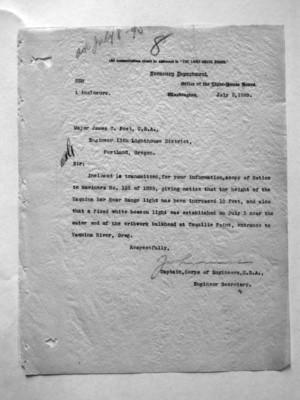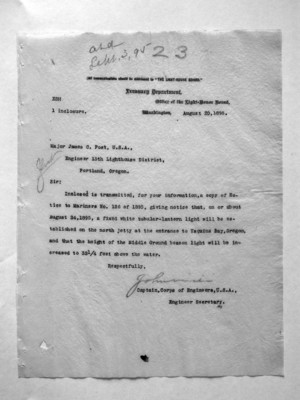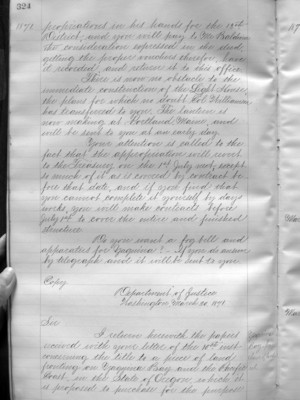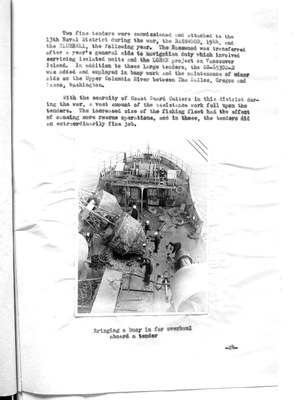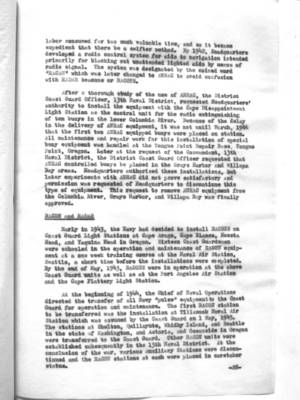Pages That Mention Washington
Box 245 1893 to 95 YB lights CF repairs
12
Treasury Department, ESH, Office of the Light-House Board, 1 inclosure. Washington, July 2, 1895.
Major James C. Post, U.S.A., Engineer 13th Lighthouse District, Portland, Oregon,
Sir: Inclosed is a transmitted, for your information, a copy of Notice to Mariners No. 105 of 1985, giving notice that the height of the Yaquina Bar Rear Range light has been increased 10 feet, and also that a fixed white beacon light was established on July 1 near the outer end of the cribwork bulkhead at Coquille Point, entrance to Yaquina River, Oreg.
Respectfully, John ??? Captain, Corps of Engineers, U.S.A., Engineer Secretary.
13
Treasury Department, ESH Office of the Light-House Board, 1 inclosure. Washington, August 20, 1895.
Major James C. Post, U.S.A., Engineer 13th Lighthouse District, Portland, Oregon.
Sir: Inclosed is transmitted, for your information, a copy of Notice to Mariners No. 126 of 1895, Giving notice that, on or about August 24, 1895, a fixed white tubular-lantern light will be established on the north jetty at the entrance to Yaquina Bay, Oregon, and that the height of the Middle Ground beacon light will be increased to 32 1/2 feet above the water. Respectfully, John ??? Captain, Corps of Engineers, U.S.A., Engineer Secretary.
1870-73 Lighthouse Board Annual Reports
17
(ap)propriations in his hands for the 13th District, and you will pay to Mr. Baldwin the consideration expressed in the deed getting the proper vouchers therefor have it recorded and return in to this office.
There is now no obstacle to the immediate construction of the Light House, the plans for which no doubt Col. Williamson has transferred to you. The lantern is now making at Portland, Maine, and will be sent to you at an early day.
Your attention is called to the fact that the appropriation will revert to the Treasury on the 1st July next, except so much of it as is covered by contract before that date, and if you find that you cannot complete it yourself by days works, you will make contracts before July 1st to cover the entire and finished structure.
Do you want a fog bell and apparatus for Yaquina?- If you do answer by telegraph and it will be sent to you.
Copy. Department of Justice. Washington, March 20, 1871.
Sir:
I return herewith the papers received with your letter of the 10th inst. concerning the title to a piece of land fronting on Yaquina Bay and the Pacific Coast, in the State of Oregon, which it is proposed to purchase for the purpose
Coast Guard District narrative histories 1945
7
Two fine tenders were commissioned and attached to the 13th Naval District during the war, the BASSWOOD, 1944, and the BLUEBELL, the following year. The Basswood was transferred after a year's general aide to navigation duty which involved servicing the isolated units and the LORAN project on Vancouver Island. In addition to these large tenders, the CO-65302-D was added and employed in buoy work and the maintenance of minor aids on the Upper Columbia River between The Dalles, Oregon and Pasco, Washington.
With the scarcity of Coast Guard Cutters in this district during the war, a vast amount of the assistance work fell upon the tenders. The increased size of the fishing fleet had the effect of causing more rescue operations, and in these, the tenders did an extraordinarily fine job.
(Photo inserted here)
Bringing a buoy in for overhaul aboard a tender
-24-
11
labor consumed far too much valuable time, and so it became expedient that there be a swifter method. By 1942, Headquarters developed a radio control system for aids to navigation intended primarily for blacking out unattended lighted aids by means of radio signal. The system was designated by the coined word "RACAN" which was later changed to ANRAC to avoid confusion with RADAR beacons or RACONS.
After a thorough study of the use of ANRAC, the District Coast Guard Officer, 13th Naval District, requested Headquarters' authority to install the equipment with the Cape Disappointment Light Station as the control unit for the radio extinguishing of ten buoys in the lower Columbia River. Because of the delay in the delivery of ANRAC equipment, it was not until March, 1944 that the first two ANRAC equipped buoys were placed on station. All maintenance and repair work for this installation of special buoy equipment was handled at the Tongue Point Repair Base, Tongue Point, Oregon. Later at the request of the Commandant, 13th Naval District, the District Coast Guard Officer requested that ANRAC controlled buoys be placed in the Grays Harbor and Willapa Bay areas. Headquarters authorized these installations, but later experiments with ANRAC did not prove satisfactory and permission was requested of Headquarters to discontinue this type of equipment. This request to remove ANRAC equipment from the Columbia River, Grays Harbor, and Willapa Bay was finally approved.
Early in 1943, the Navy had decided to install RACONS on Coast Guard Light Stations at Cape Arago, Cape Blanco, Heceta Head, and Yaquina Head in Oregon. Sixteen Coast Guardsmen were schooled in the operation and maintenance of RACON equipment at a one week training course at the Naval Air Station, Seattle, a short time before the installations were completed. By the end of May, 1943, RACONS were in operation at the above Coast Guard units as well as at the Port Angeles Air Station and the Cape Flattery Light Station.
At the beginning of 1944, the Chief of Naval Operations directed the transfer of all Navy "pulse" equipment to the Coast Guard for operation and maintenance. The first RACON station to be transferred was the installation at Tillamook Naval Air Station which was assumed by the Coast Guard on 1 May, 1945. The stations at Shelton, Quillayute, Whidby Island, and Seattle in the state of Washington, and Astoria, and Oceanside in Oregon were transferred to the Coast Guard. Other RACON units were established subsequently in the 13th Naval District. At the conclusion of the war, various Auxiliary Stations were discontinued and the RACON stations at each were placed in caretaker status.
-28-
